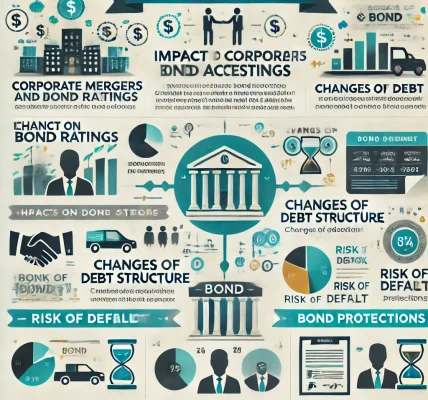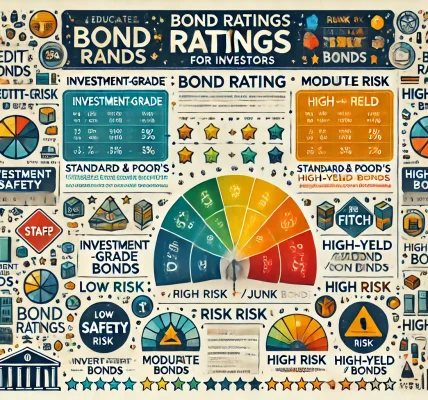Introduction
Corporate bonds are popular investment options that offer higher returns than government bonds. However, they come with a certain level of risk, including the potential for default. When a corporation is unable to meet its debt obligations, bondholders may face significant financial losses.
To safeguard your investments, it’s essential to identify early warning signs of corporate bond defaults. This comprehensive guide explores the red flags that investors should monitor, enabling them to make informed decisions and mitigate potential losses.
🎯 What Is a Corporate Bond Default?
A corporate bond default occurs when the issuing company fails to meet its obligations to pay interest or repay the principal to bondholders. This typically happens when the company faces severe financial distress, operational challenges, or poor management.
✅ Types of Defaults:
- 📉 Payment Default: Failure to make interest payments on time.
- 🛑 Principal Default: Inability to repay the bond’s principal upon maturity.
- ⚖️ Technical Default: Breach of bond covenants without immediate financial loss.
📊 Why Identifying Red Flags Early Matters
Recognizing warning signs before a default allows investors to take corrective action, such as:
✅ 1. Rebalancing the Portfolio: Reduce exposure to high-risk bonds.
✅ 2. Selling Before a Price Decline: Exit positions before the bond price plummets.
✅ 3. Seeking Legal Protection: Protect rights as a bondholder through legal recourse.
🚩 Key Red Flags to Watch for Corporate Bond Defaults
🔥 1. Deteriorating Financial Health
One of the earliest indicators of a potential default is a decline in the issuer’s financial health.
✅ Warning Signs:
- 📉 Falling Revenue and Profits: Consistent decline in earnings.
- 📊 High Debt-to-Equity Ratio: Excessive leverage compared to industry standards.
- 🧾 Negative Cash Flow: Inability to generate sufficient cash to cover interest and principal payments.
✅ How to Monitor:
- Analyze quarterly and annual financial reports.
- Compare financial ratios with industry peers.
🕒 2. Downgrade in Credit Ratings
Credit rating agencies, such as Moody’s, S&P, and Fitch, evaluate the creditworthiness of bond issuers.
✅ Warning Signs:
- ⬇️ Credit Downgrade: A downgrade signals increased default risk.
- 🚨 Negative Outlook: Agencies issuing warnings of potential future downgrades.
✅ How to Monitor:
- Regularly review credit rating reports.
- Watch for changes in the issuer’s credit outlook.
📊 3. Increased Debt and Liquidity Concerns
High levels of debt and a lack of liquidity are strong indicators that a company may be heading towards default.
✅ Warning Signs:
- 💸 Rising Debt Levels: Excessive borrowing that exceeds the company’s repayment capacity.
- 💧 Low Liquidity Ratios: Declining current and quick ratios indicate difficulty in meeting short-term obligations.
✅ How to Monitor:
- Evaluate debt-to-equity and interest coverage ratios.
- Analyze liquidity position and working capital trends.
🛑 4. Consistent Negative Earnings or Losses
Sustained losses over multiple quarters weaken the company’s ability to meet bond payments.
✅ Warning Signs:
- 📉 Declining Profit Margins: Erosion of operating efficiency.
- 🔥 Inconsistent Revenue Growth: Fluctuations in sales and earnings.
✅ How to Monitor:
- Track profit margins, earnings per share (EPS), and operating income.
- Review management commentary for concerns about declining profits.
⚠️ 5. Delay in Financial Reporting and Audit Concerns
Delayed or inconsistent financial reporting is a major red flag indicating possible mismanagement or fraud.
✅ Warning Signs:
- ⏰ Late Filing of Financial Statements: Missing deadlines for quarterly or annual filings.
- 📄 Qualified or Adverse Audit Opinions: Auditor concerns about the company’s financial practices.
✅ How to Monitor:
- Check regulatory filings on platforms like SEC EDGAR.
- Review auditors’ opinions and remarks.
📉 6. Management Changes and Governance Issues
Frequent changes in senior management or governance concerns may indicate internal turmoil that could affect financial stability.
✅ Warning Signs:
- 🔄 Sudden CEO/CFO Departures: Frequent leadership changes.
- 📚 Poor Corporate Governance Practices: Lack of transparency or questionable decision-making.
✅ How to Monitor:
- Follow press releases and news related to management changes.
- Analyze corporate governance practices through company disclosures.
🔥 7. Increasing Legal and Regulatory Risks
Legal challenges, investigations, or regulatory scrutiny can severely impact a company’s financial stability.
✅ Warning Signs:
- ⚖️ Pending Litigation: Major lawsuits that could lead to financial penalties.
- 🚫 Regulatory Violations: Violations of industry regulations or non-compliance with standards.
✅ How to Monitor:
- Track legal updates and regulatory announcements.
- Analyze risk disclosures in annual reports.
📊 8. High Yield Spread Compared to Peers
A widening yield spread indicates that investors perceive the bond as riskier compared to similar instruments.
✅ Warning Signs:
- 📈 Rising Yield Spreads: Increasing spreads compared to industry averages.
- 🔥 Increased Volatility: Price fluctuations and inconsistent yields.
✅ How to Monitor:
- Compare yield spreads with industry benchmarks.
- Watch for spikes in volatility and price movements.
💡 How to Safeguard Your Investments Against Defaults
✅ 1. Diversify Your Bond Portfolio
Avoid over-concentration in any one sector, issuer, or credit rating.
✅ Action Plan:
- Allocate bonds across different industries and maturities.
- Include a mix of government bonds, corporate bonds, and high-yield bonds.
✅ 2. Conduct Regular Credit Analysis
Perform ongoing credit analysis to monitor changes in the financial health of issuers.
✅ Action Plan:
- Review financial statements and earnings reports quarterly.
- Monitor key financial ratios and liquidity indicators.
✅ 3. Stay Updated on Credit Ratings and Yield Trends
Credit rating downgrades and changes in yield spreads offer early warnings of potential default risks.
✅ Action Plan:
- Follow updates from rating agencies and bond market news.
- Track changes in bond yields and market sentiment.
✅ 4. Set Clear Exit Strategies
Establish predefined exit strategies to minimize losses if a bond shows signs of default risk.
✅ Action Plan:
- Set price and yield thresholds for selling.
- Monitor changes in bond liquidity and market sentiment.
⚠️ 5. Seek Legal Protection When Necessary
If a default seems imminent, take proactive steps to protect your rights as a bondholder.
✅ Action Plan:
- Consult legal counsel for bondholder rights.
- Consider joining bondholder groups to negotiate with the issuer.
🎉 Conclusion: Protecting Your Portfolio from Corporate Bond Defaults
Identifying potential red flags early is key to safeguarding your bond investments from default risks. By closely monitoring financial indicators, credit ratings, governance practices, and market trends, investors can make informed decisions and protect their portfolios.
✅ Proactive Risk Management: Regularly review bond issuers’ financial health.
✅ Diversification and Exit Strategies: Spread investments across sectors and act decisively during warning signs.
By staying vigilant and adapting to market changes, investors can successfully navigate the complexities of corporate bond investing and minimize default risks.




